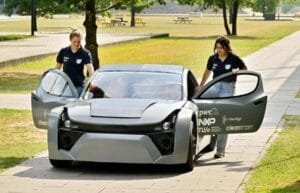Why was the invention of the Sunmobile considered revolutionary despite its small size?

In the history of technology, there are inventions that, despite their seemingly insignificant size and straightforward design, have a significant impact on shaping the future. An excellent illustration is the Sunmobile, a small vehicle powered by the sun that General Motors developed in 1955. At just 15 inches long, this miniature model might appear insignificant when viewed through the lens of modern technology. However, its creation was nothing short of revolutionary. The Sunmobile marked the first successful demonstration that sunlight could be converted into mechanical energy to power a vehicle. Despite its modest size, it opened the door to an entirely new realm of clean energy applications, symbolizing the potential of uchakk me know renewable energy and inspiring future innovations in solar transportation.
The 1950s were an era dominated by fossil fuels. Economic growth was powered largely by coal, oil, and natural gas, and the automobile industry was expanding rapidly. Sustainability was hardly regarded as a top priority, and environmental issues had not yet become widely known. In this context, the idea of powering cars with the sun’s unlimited, clean, and renewable energy seemed both futuristic and unlikely. That is precisely what made the Sunmobile so remarkable. It demonstrated a new possibility and challenged the status quo: a world in which solar power could one day be used extensively for transportation.
The Sunmobile was not a commercial product, nor was it intended for practical use. It was a scientific demonstration designed to illustrate the capabilities of photovoltaic (PV) cells. The car was powered by 12 selenium solar cells, which converted sunlight into electricity. This electricity then we can get the latest version drove a small electric motor that turned the wheels of the model. The idea was simple, but its implications were vast. For the first time, a vehicle—however small—was propelled by solar energy.
This achievement was a symbolic breakthrough, showing that sunlight could be directly converted into usable mechanical power.What made the Sunmobile revolutionary was its function as a “proof of concept.” Prior to its invention, the practical applications of solar energy were largely speculative.
The Sunmobile turned rumors into actuality. It bridged the gap between theory and reality, proving that solar energy could do more than heat water or power calculators—it could, in fact, move things. This fundamental proof provided the foundation for decades of research and development in solar-powered transportation.
Another reason the Sunmobile was revolutionary lies in its role as a catalyst for future innovation. By demonstrating the basic principles of solar-powered mobility, it inspired scientists, engineers, and inventors to think bigger. The model sparked interest in photovoltaic technology and encouraged research into improving the efficiency and practicality of solar cells.
In the decades that followed, these efforts led to the development of more advanced solar panels, energy storage systems, and full-sized solar vehicles. While the Sunmobile itself could not transport people, its influence reached far beyond its physical dimensions.
Culturally and socially, the Sunmobile also played a role in changing public perception about energy. In a time when the average consumer had little awareness of renewable energy, this small model introduced a new idea—that vehicles could run on sunlight instead of gasoline.
It captured imaginations, especially among young people and educators, and became a popular teaching tool in science classes. The model helped to demystify solar power, showing that it was not just a laboratory experiment but a real and tangible force that could be harnessed in everyday life.
The Sunmobile was especially effective as an educational and promotional tool due to its simplicity and visibility. People could see it in action, understand how it worked, and begin to imagine larger-scale applications. It served as a link between the abstract idea of solar energy and a real-world application demonstration.
It had an impact that reached far beyond the scientific community and into the general public’s consciousness, laying the groundwork for the environmental and renewable energy movements that would develop over the coming decades. In the broader context of technological development, the Sunmobile exemplifies the idea that revolutionary change often begins with modest beginnings.

Many transformative technologies start as small-scale prototypes or conceptual models. What matters most is not their size or immediate utility, but the new directions they open and the ideas they inspire. The Sunmobile’s true power lay in its ability to represent a shift in thinking—from a world dependent on finite fossil fuels to one that could, potentially, thrive on renewable sources like solar energy.
Today, solar cars are no longer just science fair projects or futuristic dreams. Teams from universities compete in international solar car races like the World Solar Challenge, where full-sized vehicles travel thousands of kilometers using only sunlight. Solar-electric vehicles that are viable for commercial use are being developed by Lightyear and Aptera. All of these advancements owe a debt to the humble Sunmobile, which first demonstrated that the sun could power movement.
In conclusion, the invention of the Sunmobile was revolutionary not because of its size or speed, but because of what it represented. It was the first practical example of solar energy being used to power a vehicle, breaking new ground in the pursuit of clean energy alternatives. It represented possibility, provided inspiration, and laid the groundwork for the solar-powered technologies that we continue to develop today.
Even though the Sunmobile was a small vehicle, it had a huge impact on sustainability, innovation, and science.